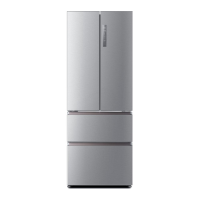5- Use
17
1 Butter, cheese, eggs, spices, etc.
2 Eggs, canned food, spices, etc
3 Drinks and bottled foods.
4 Pickled foods, canned food, etc.
5 Meat products, snack foods, etc.
6/7 Pasta, milk, tofu, dairy, etc.
8 Moist Zone drawer:
Fruit, vegetables, salad (Fruit & Veg.)
canned beverages (Q-Cool)
Rraw fresh food (0°C Fresh)
5.12 Tips on storing fresh food
5.12.1 Storing into the refrigerator compartment
▶ Keep your fridge temperature below 5°C.
▶ Hot food must be cooled to room temperature before storing in the appliance.
▶ Foods stored in the refrigerator should be washed and dried before storing
▶ Food to be stored should be properly sealed to avoid odour or taste alterations.
▶ Do not store excessive quantities of food. Leave spaces between foods to allow cold
air owing around them, for a better and more homogeneous cooling.
▶ Foods eaten daily should be stored at the front of the shelf.
▶ Leave a gap between foods and the inner walls, allowing air owing. In special way
don’t store foods against the rear wall: foods could freeze against rear wall. Avoid di-
rect contact of food (especially oily or acidic food) with the inner liner, as oil/acid can
erode the inner liner. Clean away oily/acid dirt whenever it is found.
▶ Frozen food can be gently thawed in the refrigerator compartment. This saves en-
ergy.
▶ The ageing process of fruit and vegetables such as courgettes, melons, papaya, ba-
nana, pineapple, etc. can be accelerated in the refrigerator. Therefore, it is not advis-
able to store them in the refrigerator. However, the ripening of strongly green fruits
can be promoted for a certain period. Onions, garlic, ginger and other root vegeta-
bles should also be stored at room temperature.
▶ Unpleasant odours inside the fridge are a sign that something has spilled and clean-
ing is required. See CARE AND CLEANING.
▶ Dierent foods should be placed in dierent areas according to their properties (Fig.:
5.12.1).
1
2
3
8
4
5
6
7
1
2
3
5.12.1

